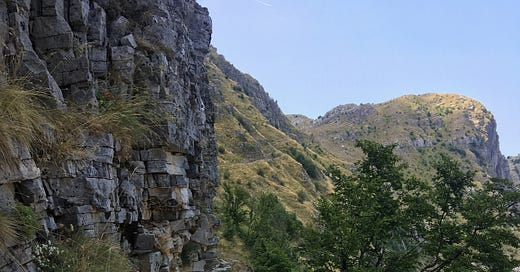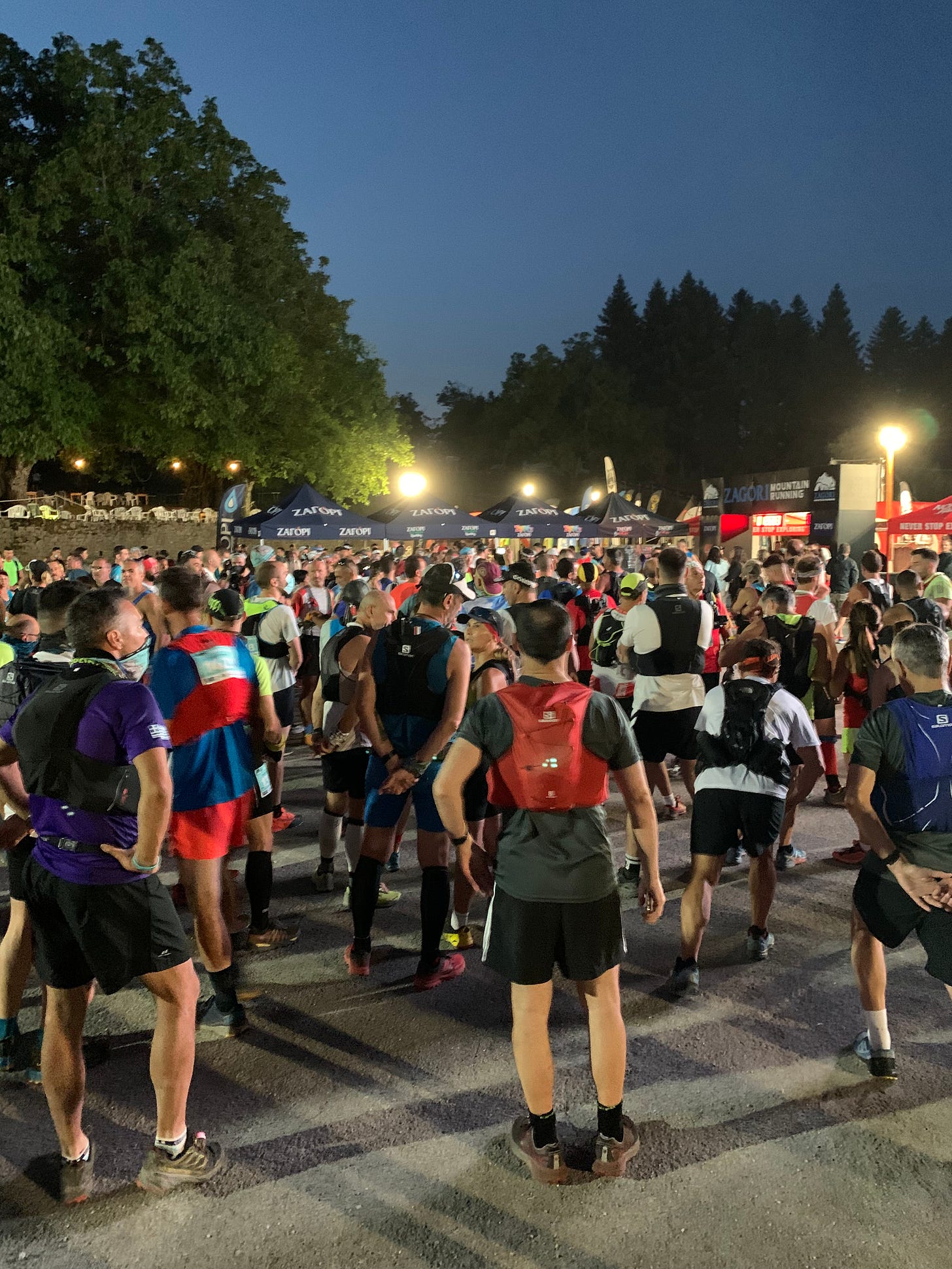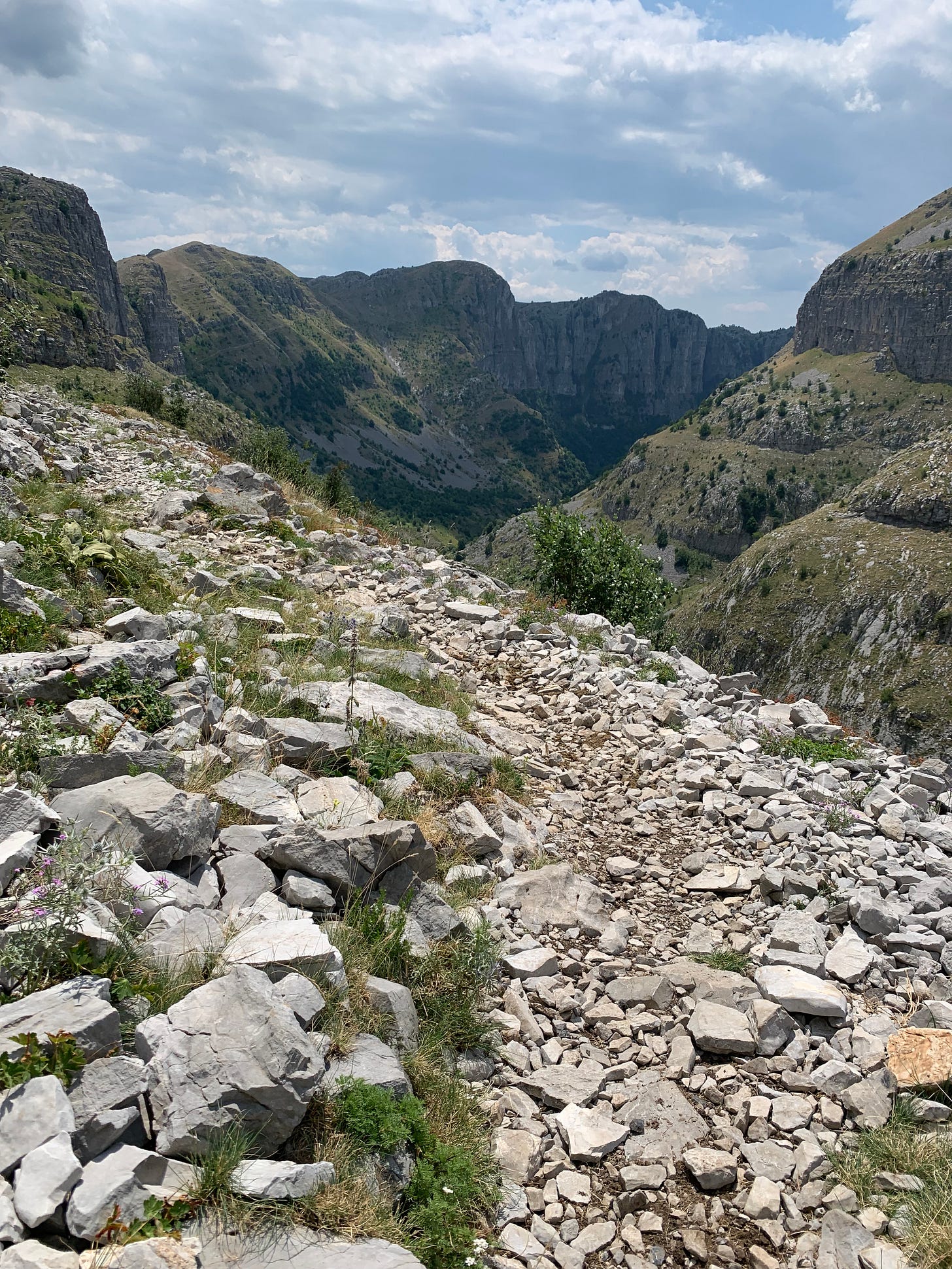A Full Moon, a Wild Boar, Two Gorges, and 44km
Or, how I ran the Zagori Mountain Running Marathon+ and discovered some surprises
When you test yourself in a new way, it seems the lessons come from what ends up surprising you. Last Saturday, as I ran the Zagori Mountain Running 44km race, I racked up a number of surprises: things that I had not expected to move me, things I had not expected to scare me, various pains I had not expected to feel. The whole experience has left me in a strange state of combined satisfaction and impatience. I’m satisfied that I did indeed finish the race and I’m impatient for next year when I can, hopefully, do better. It’s taking a while to sink in, but I’m pleased to realize that I have now run (well, walked and run) longer than I ever had before. 27 miles is my new and current limit. Now I wonder what it will feel like to do 30.
I learned some things about myself—as one does in these endeavors (and isn’t that the point). And while overall, I confirmed or discovered strengths, I also learned that there are things that newly make me uneasy. These are the things I want to hold up to the light and examine. I don’t think I can make them go away, necessarily, but I think I can understand them a bit better and work with them for the next time.
Nerves have to go somewhere when you’re anticipating something difficult. And for me, the nerves went to the drive I would have to do on the morning of the race, leaving the village of Papingo no later than 4:00am so as to be in Tsepelovo by 5:30 with enough time to orient myself for the 6:00am start. It’s not a casual drive. Even during the day, you have to stick your head out the driver’s side window to scan the hairpin road ahead for an oncoming car as you make a turn. There is often no guardrail, and often a steep drop. Though I have driven hundreds of miles on these same roads without incident, I had become suddenly nervous about the road that would, it seemed to me, be the first challenge in a long and challenging day. But in fact the journey turned out to be magical, under a full moon that might as well have been a constant streetlight. At one point, a wild boar ambled into the brush by the side of the road, a narrow, muscly beast with a head like an axe, and this seemed a strangely good omen of adventure, not fear.
Tsepelovo was crawling with runners, everybody jogging around with headlamps, greeting teammates, eating last-minute energy bites. At the starting area, I drifted towards the back of the crowd. Chip timing meant there was no need to crowd the line—as the announcer kept reminding everyone in a uniquely Greek combination of formal eloquence and friendly chiding. “Now, really, you are not listening to me,” she said at one point. In the dawn, we were a pack of runners in race vests and trail shoes, many already carrying running poles at the ready. A huge screen showed drone footage of previous races. Greek rock music pumped over the PA. We joined in a countdown, and we were off.
Surprise Number One: I was holding back tears as I crossed the start. All I could think of was how long I had been training (four or five months), and how long I had been waiting to do this race (two years), and how many more years I’d been aspiring to link together in one race, one day, all the many miles of trails I’ve been hiking up here my whole life. I couldn’t believe I was finally doing it, starting the race I’ve been dreaming about for so long.
The route took us through the village and up a steep mountainside for the first few kilometers. A one-person-wide stone bridge over a little stream created a traffic jam and so we all chatted during the stop and go. Soon after, we began to really run, and I encountered Surprise Number Two which shouldn’t have been a surprise. The calf muscle that had been spasming and tightening under strain for a couple of weeks tightened up again, and it occurred to me properly for the first time that I might have to pull out of the race. I kept going, propelled by that peculiar inertia that can make us fail to realize that stopping is the better thing to do. But I knew that, worst-case scenario, I could walk the thirteen miles to Papingo and bail there, where I could prevail upon my son to drive me back to Tsepelovo and get my car. It turned out that I could go on. I did feel the calf the whole time, and it did affect my gait. I had little elasticity and fluidity to my stride, which was a shame because that is one of the best things about trail running—the ability, the need, to be fluid and irregular with your movements. I did what I could, using my running poles to help cushion and guide the downhills, running on the flats as much as possible (though there were hardly any flats), and plodding upwards with my quads and glutes to spare the calf.
Surprise Number Three is one I’m sheepish about. I simply did not consume enough calories. I did well on hydration, but I had packed hardly enough chews in my race vest and, at the mid-race aid station in Papingo, ate only one and a half bananas when I could have had hundreds more calories to fuel me. Leaving Papingo sent us onto a four-mile climb of 3,000 feet, having already just done another two miles with almost as much gain. I’ve probably hiked and run this stretch literally thirty times in my life, but never have I felt so dead in the legs as last Saturday. Let’s not talk about the pace I held. My solace was that, having already passed the only three women I had seen on the trail (there were many others ahead of me), I passed two more on the way up. A lesson for next time? Eat more food! I think I had slipped into a mindset that, as I was already under way, this was my norm and I didn’t have to take extra measures. I didn’t have to eat extra food. But it’s important to remember, in situations like this and other life situations, that just because something is already in progress, just because you are habituated to it, that doesn’t mean you shouldn’t take appropriate/extra measures to take care of yourself.
The second half of the race took me over terrain I know by heart, and then onto terrain I first encountered only two years ago on a beautiful long hike from the very village of Tsepelovo. Saturday, I was going in the reverse direction, but I knew I was headed to the mile-long section that runs above the gorge of Megas Lakkos—and specifically to one spot I had photographed in 2019: a narrow ledge with a cable anchored into the rock to hold onto and a caution sign painted on the trail.
And here was Surprise Number Four. I found not just that spot but the entire mile above the gorge to be very nerve-wracking. I do believe I was safe (around 300 runners had already traversed this stretch without incident, and at greater speed) but I felt I had to place every step with tremendous care. I kept my head down, scrutinizing the footing, not looking out over the gorge, just continuing one step at a time even over places where I had to use both hands to scramble up and over narrow crags. At the same time, I was quietly angry with the choice of route—which was silly because, again, everybody went through it safely and many went through it at twice my speed. Two years ago, I myself had ambled along this very path (granted, going slightly downhill and early in a hike, not after already trekking 22 miles) without a single care, taking photos and admiring the view. In reality, it was myself I was annoyed with—for succumbing to fatigue and nerves.
Once I crested the lip of the gorge, found the next-to-last aid station, ate the best and saltiest potato chips I’ve ever tasted, and began the descent into the village, I relaxed. But the memory of that fear has stayed with me. I don’t know that I will ever be able to run or hike or walk that stretch of trail without feeling nervous. So, rather than try to ignore the fear, I need to practice working with it, staying calm in spite of it, as I was trying to do on Saturday. On the plus side, I didn’t freeze up but controlled my fear enough to keep going.
Two surprises remain. The first was the thunderous applause and cheering for me (and for every runner) as I came through the main square of Tsepelovo. I first thought I was almost intruding on people’s social time to be running through the square. But then how could I not smile and wave as—after dodging a toddler—I came through to the finish line, 43rd out of 48 women in a field of 350 runners? The second surprise is that feeling that I think is common when we engage in these pursuits. I’m surprised—though I shouldn’t be—that I’m not entirely pleased with my finish, even though it’s within the range I expected. I told myself I would finish between 8 1/2-10 hours, depending on what would happen with my calf and I finished in 10. But I’m kind of annoyed about it. Even though I finished within my goal range, I’m disappointed I didn’t do better.
I think I can. I think if I don’t have an injury and if I fuel right and if I do the mental training to be more confident on that mile in Megas Lakkos, I can shave an hour off my time. There, I said it. Because I am for sure not finished with this race. The whole event is too majestic, too moving, too emotional for me not to try again. Even before Saturday, I had a memory associated with all but two of the 27 miles of trail. Now I have memories for all of it: the chats with fellow runners along the way, the isolated aid station that championed its dried apricots as the best delicacy and poured out its ice-cold water (how did they do that) with a flourish, the encounters on the way up with the racers from the 80km race coming down, exchanges of bravo and καλη συνεχια (good onward journey) with everyone along the way, the cows on the high plateau, the eagles, my son and his girlfriend at the finish line, the heavy finisher’s medal that I will keep with pride. I can’t wait for next year.








So great!! Congrats :)
Fan! Thanks for sharing.